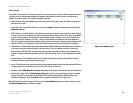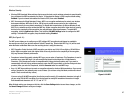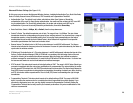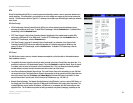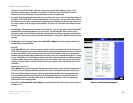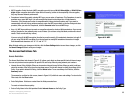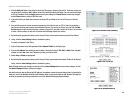
31
Chapter 6: Configuring the Router
The Security Tab
Wireless-G VPN Broadband Router
VPN
Virtual Private Networking (VPN) is a security measure that basically creates a secure connection between two
remote locations. This connection is very specific as far as its settings are concerned; this is what creates the
security. The VPN screen, shown in Figure 6-17, allows you to configure your VPN settings to make your network
more secure.
VPN PassThrough
• IPSec Passthrough. Internet Protocol Security (IPSec) is a suite of protocols used to implement secure
exchange of packets at the IP layer. To allow IPSec Passthrough, click the Enabled button. To disable IPSec
Passthrough, click the Disabled button.
• PPTP Pass Through. Point-to-Point Tunneling Protocol Passthrough is the method used to enable VPN
sessions to a Windows NT 4.0 or 2000 server. To allow PPTP Passthrough, click the Enabled button. To
disable PPTP Passthrough, click the Disabled button.
• L2TP Pass Through. Layering 2 Tunneling Protocol Passthrough is an extension of the Point-to-Point
Tunneling Protocol (PPTP) used by to enable the operation of a virtual private network (VPN) over the
Internet.To allow L2TP Passthrough, click the Enabled button. To disable L2TP Passthrough, click the
Disabled button.
VPN Tunnel
The VPN Router creates a tunnel or channel between two endpoints, so that the data or information between
these endpoints is secure.
• To establish this tunnel, select the tunnel you wish to create in the Select Tunnel Entry drop-down box. It is
possible to create up to 100 simultaneous tunnels. Then click Enabled to enable the tunnel. Once the tunnel
is enabled, enter the name of the tunnel in the Tunnel Name field. This is to allow you to identify multiple
tunnels and does not have to match the name used at the other end of the tunnel.
• Local Secure Group and Remote Secure Group. The Local Secure Group is the computer(s) on your LAN that
can access the tunnel. The Remote Secure Group is the computer (s) on the remote end of the tunnel that can
access the tunnel. Enter the IP Address and Subnet Mask of the local VPN Router in the fields. To allow
access to the entire IP subnet, enter 0 for the last set of IP Addresses. (e.g. 192.168.1.0).
• Remote Security Gateway. The Remote Security Gateway is the VPN device, such as a second VPN Router, on
the remote end of the VPN tunnel. Enter the IP Address of the VPN device at the other end of the tunnel. The
remote VPN device can be another VPN Router, a VPN Server, or a computer with VPN client software that
supports IPSec. The IP Address may either be static (permanent) or dynamic (changing), depending on the
Figure 6-17: VPN





